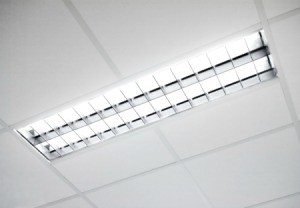 A 4 tube fluorescent fixture was previously wired for operation from two switches in different locations via 4 wire cable, blk , wht, red with bare ground wire. The fixture uses two ballasts with 8 wires each Two red, two blue, two yellow, one black and one white. The reds, blues and yellows in each ballast are paired together with a wire nut on each pair. The white wires from each ballast are twisted in a wire nut.
A 4 tube fluorescent fixture was previously wired for operation from two switches in different locations via 4 wire cable, blk , wht, red with bare ground wire. The fixture uses two ballasts with 8 wires each Two red, two blue, two yellow, one black and one white. The reds, blues and yellows in each ballast are paired together with a wire nut on each pair. The white wires from each ballast are twisted in a wire nut.

When you talk about cables, don't count the bare wire. A cable with black, red, and white is called a three-wire cable.
The white wire is the "Grounded" wire. It is grounded at the panel. However, that does not make it an equal to the bare ground wire ! Consider it a common return path for the power that goes out via the black and the red wires.
In your case, since you are not using the second switch any more, cap off and ignore the red wire in the power feed cable.
With the ballast, it seems that you have two 4-tube ballasts, with one of them being dead or a spare for future use. The black and white are the input wires. Connect the black from the good ballast to the black from the feed cable, and the white to the white from the feed cable.
The reds and the blues from one ballast go to the left ends of the tubes. The yellows go to the right end of the tubes, the end where there are probably jumper wires between the tube holders.
Try it first with the ballast that has a bare ground attached to it. Chances are that the other ballast is dead but that somebody was too lazy to remove it. That is quite common when removing the ballast would require taking the fixture down. Usually, though, the wires on the dead ballast are clipped off right close to the ballast.
Whether there is a bare ground attached to the metal can of the ballast or not, that makes no difference in the lighting, but it drastically cuts down the hum that you would hear on nearby older radios.
Have FUN!
DearWebby
www.webby.com/